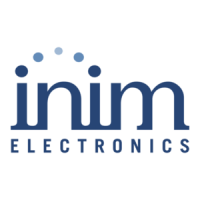116 Technical terminology and Glossary
Anti-intrusion control panels
This type of zone usually comprises a shock detector (e.g Glassbreak detector) which senses for
shock waves (vibration caused by hard blows).
SHOCK ZONE
The shortcuts are control panel functions which, in a single activation, provide a fast way of
carrying out specific operations which would normally require a series of activations.
They can be activated by the end-user (at keypads, on codes typed in at keypads or on remote
telephones, at readers or on keys) or on the occurrence (activation) of an event.
The shortcuts that can be activated by the user allow direct access to the user menu sections and
various operations which normally require several steps inside the user menu.
For example, to activate/deactivate an output manually, you must:
• type in a user code
• access the User Menu
• access the option in the appropriate section (activate outputs)
• select the output
• activate/deactivate the selected output as required
Instead, the “Activate Output” and “Deactiv. Output” shortcuts allow you to activate/deactivate an
output by simply pressing a single key or, if required for security reasons, after entering a user
code.
Some shortcuts (for example, “Activate Outputs”) require details before the system can
implement them. These details (parameter, value, etc.) depend on the source of the shortcut
command (keypad, code, reader, keys).
SHORTCUTS
Optical smoke detectors are equipped with sampling chambers (based on light scattering mass -
Tyndall effect). They are capable of sensing the presence of smoke particles and thus detecting a
fire in its early stages.
These detectors have low power absorption during standby. The current absorption increases
during alarm status and thus signals the danger of fire to the control panel.
SMOKE DETECTORS
An output that is monitored and therefore allows verification of its improper operating capacity
(unsuccessful activation/deactivation).
SUPERVISED OUTPUT
The “supervision time” is the interval during which the wireless-system devices (in general
wireless detectors in permanent placements) must signal to the control panel that they are
operating in the network. If a wireless device fails to signal before the “supervision time” expires,
it will be classified as “Lost” and the control panel will trigger a “peripheral-loss” fault event.
SUPERVISION
Detection of a serious condition that jeopardizes the operating capacity of the device concerned
and thus puts the system at risk.
Tamper conditions are detected by tamper switches connected to the system zones, keypads,
readers, expansions and control panel. Generally, these events are triggered by system violation
such as unauthorized opening of a keypad cover.
TAMPER
These are calls sent to programmed contact numbers when specific events start and end
(restoral).
TELEPHONE ACTIONS
This is a service provided by the installer company with the user's collaboration. The installer
connects to the control panel over-the-phone or via a GPRS or Internet connection and, in this
way, can check and/or change the control panel programming data.
TELESERVICE
Screw terminal for the connection of zones (detection devices) or outputs (command/ signalling
devices).
The terminals (with some exceptions) of the control panel, keypads and expansion boards can be
configured as:
• Input zone
• Double zone (ZONE DOUBLING)
•Output
•Supervised output
• Unused terminal
TERMINAL
A zone with this attribute cannot generate alarms (activate audible and visual signalling devices).
However, any alarm events which occur will be saved to the events memory.
The installer usually assigns the “test” attribute when the system is undergoing tests, in order to
avoid false alarms. In this way, the installer can see if a zone is operating properly by simply
referring to the events log.
TEST ZONE
A logical entity for automatic time-management of programmed peripherals or elements.
SmartLiving control panels provide 10 timers.
Each timer can be programmed to manage:
• An activation time (ON Time) and a deactivation time (OFF Time) on preset days of the week and
specific dates.
• 5 timer-slot exceptions. Each "exception" refers to a specific interval of one or more days, which can
be programmed with an ON and OFF Time.
The timers can be used for different purposes:
• If a timer is associated with a partition, the system will arm and disarm the partition automatically in
accordance with the On/Off settings of the timer.
• If a timer is associated with a code, the latter will be allowed to access the system only when the
timer is On.
• If a timer is associated with a key, the latter will be allowed to access the system only when the
timer is On.
• If the “Timer xxx” event is assigned to an output, the latter will activate/deactivate the connected
device in accordance with the On/Off settings of the timer.
No matter how they are employed, the timers must always be enabled by the user.
TIMER
Transceiver-equipped devices
In two-way wireless systems, all the devices are equipped with transceivers. In one-way wireless
systems, the main unit is equipped with a receiver module whereas the peripheral devices are
equipped with transmitters.
TRANSCEIVER

